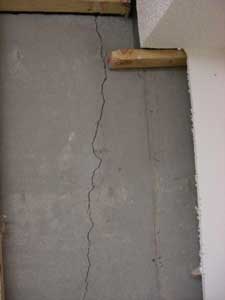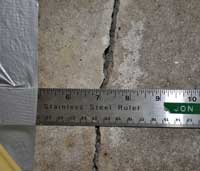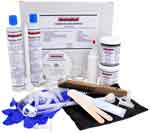Basement Wall Cracks Got You Down?
Are you tired of constantly worrying about water seepage or structural damage in your basement due to cracks in your wall? It’s time to take control and repair those cracks on your own. With the right tools and a little bit of know-how, basement wall crack repair can be a simple and inexpensive DIY project. Say goodbye to the hassle and cost of hiring professional and embrace the satisfaction of fixing it yourself.
For more than 25 years, RadonSeal has been empowering homeowners and DIY’ers alike, by providing professional-grade, easy-to-use, basement foundation crack repair kits. So save your time and your money and fix ’em like the pros!
How Basement Wall Cracks Develop
 Cracks in poured concrete foundation walls can be found in almost all residential and commercial properties. Ideally, choosing the best repair method, starts with identifying the cause of the crack. Sometimes a basement wall crack can be attributed to a single, easily identifiably cause, making the repair method straight froward – for example, cleaning a clogged gutter and using extension to divert rainwater far away from the foundation wall. In other cases, cracks can be caused by a combination of factors or the exact cause may never be identified.
Cracks in poured concrete foundation walls can be found in almost all residential and commercial properties. Ideally, choosing the best repair method, starts with identifying the cause of the crack. Sometimes a basement wall crack can be attributed to a single, easily identifiably cause, making the repair method straight froward – for example, cleaning a clogged gutter and using extension to divert rainwater far away from the foundation wall. In other cases, cracks can be caused by a combination of factors or the exact cause may never be identified.
Concrete block foundation walls are not immune to cracking either. “Step cracks” are very common in block foundations. These cracks follow along the mortar joints, forming a step-like pattern as they travel up and down the wall. Mortar joints are typically the weakest points on block walls, so step cracks are the most common type of crack. However, concrete block foundation walls can also develop cracks directly through the block face, making the repair more difficult.
When a basement crack is identified, it is highly advisable to repair it as soon as possible. After all, cracks are direct pathways from the soil into your home. Water, humid air, soil gases, and bugs pass through cracks very easily.
Some common causes of concrete cracks are:
- Improper Concrete Mix (high water content)
- Rapid Concrete Curing
- Improper Expansion Control Joints
- Premature Removal of Concrete Forms
- Premature Backfilling
- Improper Compaction of Fill Soil
- Expansive Clay Soils
- Uneven Moisture Around the Foundation
- Plumbing Leaks
- Poor Drainage
- Hydrostatic Water Pressure
Types of Foundation Wall Cracks
 When is comes to basement wall cracks, we initially break them into two groups based on their direction of travel.
When is comes to basement wall cracks, we initially break them into two groups based on their direction of travel.
VERTICAL CRACKS – Most often, basement wall cracks travel vertically or in a diagonal direction. It is fairly common to see a crack starting at basement window corners, along cold joints and seams, or around holes for utility service lines, or near tie rods. Vertical hairline cracks typically that develop within the first month, and are usually caused by shrinkage in the concrete. Wider cracks generally signal settling of the backfill around the foundation. In most cases, vertical cracks pose no structural concerns and will not lead to foundation failure. The biggest problem they cause is water leakage, and radon transmission into the basement.
HORIZONTAL – Clay soils in some areas are highly expansive. As the soil gets repeatedly wet and dry, it expands and shrinks, exerting lateral pressure on the foundation walls. If you have horizontal cracks along the midpoint of the wall, the wall is subjected to lateral pressure, which could bow and structurally damage the wall.
Cracks more than 1/4-inch wide, horizontal cracks in walls, cracks with misaligned edges or continuing movement may require professional assessment. You can monitor the crack’s length and movement by marking off the ends of the crack and making several “alignment marks” across the crack at various points.
Foundation repair contractors can fix failed foundations by:
- Slab Jacking – Involves pumping a cement grout through small holes in the concrete slab
- Piering – Involves strategically placed mechanical jacks for lifting the settled beam to grade
Low-Pressure Basment Crack Repair for Homeowners & Pros
 Polyurethane Injection – Crack injection works by filling the full length and depth of the crack with expandable polyurethane foam or epoxy. It forms permanent waterproofing seal so the process never needs to be repeated. Unlike surface repairs, the injected polymer is not vulnerable to weathering, ultraviolet rays, or traffic.
Polyurethane Injection – Crack injection works by filling the full length and depth of the crack with expandable polyurethane foam or epoxy. It forms permanent waterproofing seal so the process never needs to be repeated. Unlike surface repairs, the injected polymer is not vulnerable to weathering, ultraviolet rays, or traffic.
Filling the full depth of the crack rather than just bridging it on the surface prevents further deterioration of the concrete by groundwater. In addition, the injected polymer coats reinforcing steel and starves the corrosion process.
But most importantly, crack injection prevents future expensive problems. The potential damages done by water leaks to the finished basement or the cost of repairing concrete spalls caused by corrosion of reinforcing steel make clear the advantages of permanent crack repair.
Epoxy Injection is appropriate when structural strength of the repair is needed.
Review our DIY Homeowner Crack Repair Kits or our PRO Crack Repair Kits
Basement Crack Repair in Concrete Blocks Walls
While crack injection is best used for sealing cracks in poured concrete wall, it is not suitable for hollow concrete blocks. The reason is that the foam or epoxy would leak and wastefully expand in the hollow cores of the blocks. The proper repair would be routing out the crack with a hand-held grinder and then fill it with our ElastiPoxy Joint & Crack Filler Kit mixed with sand.
Need to Repair a Floor Crack? Use CrackWeld® Floor Repair Kit.